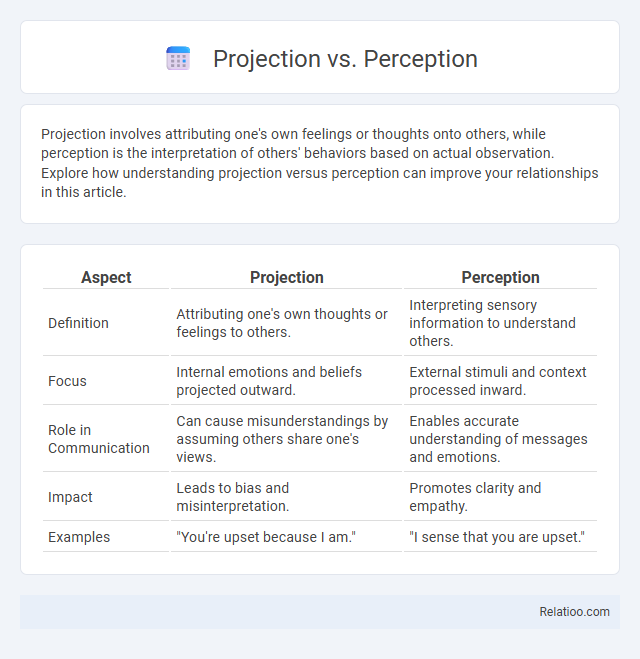Projection involves attributing one's own feelings or thoughts onto others, while perception is the interpretation of others' behaviors based on actual observation. Explore how understanding projection versus perception can improve your relationships in this article.
Table of Comparison
| Aspect | Projection | Perception |
|---|---|---|
| Definition | Attributing one's own thoughts or feelings to others. | Interpreting sensory information to understand others. |
| Focus | Internal emotions and beliefs projected outward. | External stimuli and context processed inward. |
| Role in Communication | Can cause misunderstandings by assuming others share one's views. | Enables accurate understanding of messages and emotions. |
| Impact | Leads to bias and misinterpretation. | Promotes clarity and empathy. |
| Examples | "You're upset because I am." | "I sense that you are upset." |
Understanding the Concepts: Projection and Perception
Projection involves attributing your own feelings or thoughts onto others, often distorting reality based on internal biases. Perception is the process through which your brain interprets sensory information to create an understanding of the external world. Mastering the difference between projection and perception is crucial for accurate self-awareness and improving interpersonal communication.
The Psychology Behind Projection
Projection in psychology refers to the unconscious defense mechanism where individuals attribute their own unwanted feelings or thoughts onto others. Perception involves the process by which individuals interpret and make sense of sensory information, influenced by prior experiences and cognitive biases. Understanding the psychology behind projection highlights how distortions in perception can lead to misattributing one's internal conflicts onto external objects or people.
How Perception Shapes Reality
Perception shapes reality by filtering and interpreting sensory information through individual cognitive frameworks, beliefs, and experiences, which often leads to subjective interpretations rather than objective truths. This psychological process impacts decision-making, social interactions, and emotional responses, as people tend to project their own expectations and biases onto external situations. Understanding how perception constructs personal realities allows for greater awareness of projection's influence and the potential misalignment between perceived and actual events.
Key Differences Between Projection and Perception
Projection involves attributing your own feelings or thoughts onto others, while perception is the process of interpreting sensory information to understand the environment accurately. Your perception relies on objective observation and cognitive processing, whereas projection distorts reality by inserting personal biases. Understanding these key differences helps improve interpersonal communication and self-awareness.
Real-Life Examples of Projection
Projection occurs when individuals attribute their own feelings or thoughts to others, such as a person accusing a colleague of hostility when they themselves are angry. Perception involves the sensory experience and interpretation of information, like noticing someone's facial expressions to gauge their mood. Real-life examples of projection include blaming others for personal mistakes or insecurities, such as a partner accusing their significant other of cheating when they harbor mistrust or jealousy.
The Role of Perception in Everyday Decisions
Perception plays a crucial role in everyday decisions by shaping how individuals interpret and respond to their environment, influencing choices based on sensory input and cognitive biases. Unlike projection, which involves attributing one's own feelings or thoughts onto others, perception directly affects real-time understanding and adaptation. Accurate perception enhances decision-making by enabling effective assessment of risks and opportunities in daily life.
Projection in Relationships: Impact and Consequences
Projection in relationships involves attributing your own feelings or thoughts onto your partner, often leading to misunderstandings and conflicts. This defense mechanism can distort communication, causing you to misinterpret your partner's intentions and emotions, which erodes trust and intimacy. Recognizing and addressing projection promotes healthier interactions and emotional clarity, enhancing relationship stability.
Cognitive Biases Affecting Perception
Cognitive biases such as confirmation bias, anchoring, and stereotyping significantly distort your perception by filtering information through preconceived beliefs, leading to projection--attributing your own feelings or thoughts onto others inaccurately. These biases create a gap between objective reality and subjective experience, resulting in misinterpretations during social interactions. Understanding how these cognitive biases influence perception helps mitigate projection errors and improves clarity in communication and decision-making.
Overcoming the Pitfalls of Projection
Projection occurs when you attribute your own emotions or thoughts onto others, while perception involves interpreting sensory information accurately. Overcoming the pitfalls of projection requires developing self-awareness and distinguishing between your internal biases and objective reality. By refining your perception skills and challenging assumptions, you can improve communication and relationships effectively.
Enhancing Self-Awareness for Accurate Perception
Projection involves attributing your own thoughts or feelings onto others, which can distort your perception and hinder self-awareness. Perception is the process of interpreting sensory information, but it can be influenced by biases stemming from projection. Enhancing self-awareness allows you to recognize and manage projection, leading to more accurate perception and improved interpersonal understanding.

Infographic: Projection vs Perception
 relatioo.com
relatioo.com